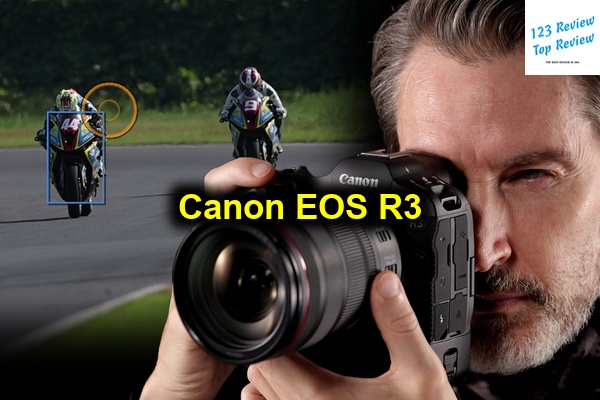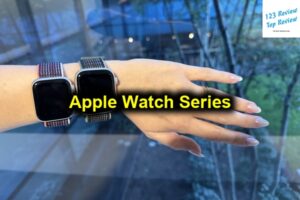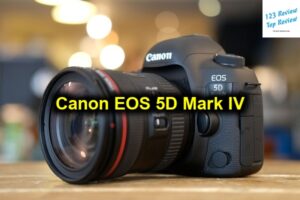The Canon EOS R3 is a groundbreaking addition to Canon’s mirrorless lineup, aimed at professional photographers and videographers who demand speed, performance, and cutting-edge technology. Building on the success of the EOS R series, the R3 introduces new features that set it apart in the competitive full-frame mirrorless market.

In this article, 123 Review delves into the detailed aspects of the EOS R3, covering design, performance, and how it compares to its peers.
Design and Build Quality
Ergonomics and Handling
The Canon EOS R3 is designed with ergonomics and functionality at the forefront. It boasts a robust, ergonomic design that fits comfortably in the hands of photographers, enabling a secure grip during extended shooting sessions. The camera’s weight distribution is excellent, providing balance whether used with lightweight primes or heavier telephoto lenses. This design consideration is critical for professionals who often need to operate their gear for long hours in varied environments.
The control layout is intuitive, featuring a combination of tactile buttons, dials, and touch controls that allow users to make quick adjustments on-the-fly without losing focus on their subject. The R3 includes a fully articulated touchscreen, enhancing compositional flexibility by offering easy access to functions and settings even when shooting at awkward angles.
Weather Sealing and Durability
Canon has ensured that the EOS R3 is built to withstand the rigors of professional use, including challenging weather conditions. The camera features comprehensive weather sealing across all joints, buttons, and the battery compartment, offering resistance to dust and moisture. This makes the R3 an ideal choice for outdoor and adventure photographers who shoot in unpredictable environments.
The magnesium alloy body provides robustness without adding unnecessary weight, delivering a durable yet manageable device. This construction instills confidence in photographers and videographers, knowing that the EOS R3 can handle the inevitable bumps and impacts encountered during fast-paced shooting.
Sensor and Image Quality
Stacked CMOS Technology
One of the most significant advancements in the Canon EOS R3 is its 24.1-megapixel stacked CMOS sensor. This sensor architecture allows for exceptionally fast readout speeds, reducing rolling shutter effects and enhancing the camera’s overall responsiveness. The stacked design enables rapid data processing, critical for high-speed shooting and advanced autofocus capabilities.
The stacked CMOS sensor delivers spectacular image quality with excellent detail, dynamic range, and color reproduction. Coupled with Canon’s DIGIC X image processor, the R3 provides remarkable performance across various lighting conditions, catering to the demanding needs of professional photography.
Low-Light Performance
The Canon EOS R3 excels in low-light situations, with an impressive native ISO range of 100 to 102,400, expandable from 50 to 204,800. This high sensitivity ensures that photographers can capture images in challenging lighting conditions without significant noise interference. The camera’s advanced noise reduction algorithms preserve detail and color accuracy even at higher ISO settings, making it suitable for night photography, indoor events, and other dimly lit environments.
The R3’s low-light autofocus is remarkably effective, allowing for precise subject acquisition even in minimal light. This capability is especially valuable for photojournalists and event photographers needing to capture moments swiftly without compromising on image quality.
Autofocus System
Eye-Control Autofocus
The Canon EOS R3 marks the return of Canon’s revolutionary Eye-Control Autofocus system, which allows photographers to set the autofocus point using their eye movement via the viewfinder. This feature adds a new dimension of control, enabling rapid focus shifts and increased accuracy in rapidly changing scenes. Eye-Control AF is particularly beneficial in sports and wildlife photography, where subjects are often in constant motion.
This intuitive focusing method complements Canon’s state-of-the-art Dual Pixel CMOS AF II technology, providing 1,053 AF points that cover nearly 100% of the frame. Photographers appreciate this system’s speed and precision, which significantly enhances both still and video shooting experiences.
Subject Tracking Capabilities
The Canon EOS R3’s subject tracking capabilities are exemplary, leveraging advanced algorithms and deep learning technology to track subjects with uncanny precision. This system can identify and follow a wide array of subjects, including people, animals, and vehicles, ensuring that they remain sharp and in focus across the frame.
This predictive tracking system is invaluable for fast-paced action photography, providing reliability in unpredictable situations where focus needs to be maintained on erratic and swiftly moving subjects. Portrait, sports, and wildlife photographers will find these capabilities particularly beneficial, allowing them to capture dynamic moments effortlessly.
Comparison to Previous Models
Compared to its predecessors, such as the EOS-1D X Mark III and EOS R5, the EOS R3 offers significant improvements in autofocus performance. The return of Eye-Control AF, improved subject recognition, and expanded AF coverage make the R3 a standout in Canon’s lineup. These advancements elevate the R3’s capability to meet the needs of professional photographers across diverse genres, setting a new standard in the mirrorless segment.
Burst Shooting and Performance
Continuous Shooting Speed
The Canon EOS R3 excels with its impressive continuous shooting capabilities. It can shoot up to 30 frames per second (fps) with the electronic shutter and 12 fps with the mechanical shutter. This high-speed performance is ideal for capturing fast-moving sequences, such as sports events, wildlife in action, or any scenario where timing is critical.
The ability to shoot at such rapid speeds without blackout enhances compositional accuracy and allows photographers to stay engaged with the scene. This level of performance is a testament to Canon’s commitment to meeting professional demands for high-paced photography.
Buffer Performance
Complementing the fast shooting speeds is the EOS R3’s outstanding buffer performance. The camera can handle approximately 540 JPEG or 150 RAW files in a single burst with a CFexpress card, ensuring that photographers can continue capturing moments without worrying about buffer limitations.
The advanced buffer management ensures quick clearance times, allowing photographers to resume shooting almost immediately. This feature is crucial during events with extensive action sequences, ensuring that the camera is always ready to capture the next decisive moment.
Video Capabilities
Video Resolutions and Frame Rates
The Canon EOS R3 is a powerhouse for videographers, offering 6K RAW recording at 60p and 4K video at up to 120p. This extensive range of resolutions and frame rates provides creative flexibility, catering to cinematic storytelling and high-speed video capture for slow-motion effects.
Canon’s commitment to delivering exceptional video quality is evident in the R3’s detailed footage, vibrant color reproduction, and seamless autofocus transitions. Filmmakers, content creators, and hybrid shooters will find the R3 a robust tool that meets various production needs, from professional productions to dynamic video blogging.
Internal Recording Options
The EOS R3 supports high-quality internal recording options, including 10-bit 4:2:2 Canon Log 3 and HDR PQ, which provide rich tonal gradients and extensive post-processing flexibility. These codecs enable filmmakers to capture footage primed for professional color grading and cinematic refinement.
The ability to record internally in multiple formats, combined with external recording capabilities via the HDMI port, positions the R3 as an adaptable option for filmmakers looking to maximize output quality while maintaining efficient workflows.
Heat Management and Recording Limits
Canon has implemented effective heat management solutions in the R3, ensuring longer recording times without overheating interruptions, even in high-resolution modes. These enhancements allow for extended recording sessions, particularly in demanding conditions where prolonged shooting is necessary.
The robust thermal design minimizes the occurrence of heat-related downtime, ensuring consistent performance even during intensive tasks. This reliability is crucial for professional videographers who cannot afford interruptions in their filming schedule.
User Interface and Controls
Menu System Usability
The Canon EOS R3 benefits from an evolved menu system designed for ease of use. The interface is intuitive, with logically organized categories and functions that make navigating through the settings straightforward. This user-friendly approach ensures photographers and videographers can quickly access and adjust critical settings without disruption to their creative flow.
The customizable My Menu section allows users to tailor the menu to their specific needs, enhancing operational efficiency. This feature is particularly beneficial for professionals who require quick access to frequently used settings during shoots.
Customization Options
Customization is a strength of the EOS R3, offering users the ability to personalize controls to match their workflow. The camera supports customization of buttons, dials, and function assignments, providing a tailored experience that adapts to various shooting styles and preferences.
This flexibility extends to the camera’s autofocus and burst modes, allowing users to configure these settings to suit specific genres, from sports to landscape photography. The level of customization available ensures that the R3 meets the diverse needs of its user base, enhancing overall usability and satisfaction.
Connectivity Features
Wireless Options
The Canon EOS R3 is equipped with comprehensive wireless connectivity options, including built-in Wi-Fi and Bluetooth. These features provide seamless integration with Canon’s Camera Connect app, allowing users to transfer images, control the camera remotely, and update firmware effortlessly.
Wi-Fi capabilities support FTP and FTPS, facilitating rapid file transfers for professional workflows that require immediate image delivery. This robust connectivity suite makes the R3 an adaptable tool for professional environments and remote operations.
Ports and External Connectivity
The EOS R3 is designed with extensive connectivity options that accommodate both photographers and videographers. It includes USB-C for fast data transfer, HDMI for external video recording, a microphone and headphone jack for audio monitoring, and a PC sync terminal for studio flash systems.
These features ensure that the R3 integrates seamlessly into professional setups, providing the flexibility needed for intricate shooting environments and high-end productions. The robust array of ports supports a wide range of peripherals, enhancing the camera’s adaptability in diverse shooting conditions.
Battery Life and Power Management
Battery Performance
The Canon EOS R3 is powered by the LP-E19 battery, the same used in Canon’s flagship DSLRs, offering excellent battery life capable of handling demanding sessions. Photographers can expect to capture approximately 620 shots per charge, depending on usage and settings.
The efficient power management system ensures that the battery drains slowly, even during extensive periods of shooting at high frames per second, video recording, or using power-intensive functions like wireless connectivity.
Charging Options
For added convenience, the EOS R3 supports in-camera USB charging, allowing for flexible power management on the go. This feature is beneficial for fieldwork, enabling users to charge the camera using portable power banks or in-vehicle USB ports, minimizing downtime between sessions.
The ability to charge the battery in-camera, along with the option to use external chargers, provides multiple power management solutions that cater to the needs of professional photographers constantly on the move.
Lens Compatibility
RF Lens Lineup
The Canon EOS R3 is fully compatible with the RF lens lineup, offering superior optical performance optimized for mirrorless cameras. The RF lenses deliver enhanced image clarity, sharpness, and color fidelity, leveraging Canon’s advanced optical technologies to maximize the potential of the R3’s high-resolution sensor.
The RF lens series includes a wide range of options, from compact primes to versatile zooms, providing photographers with the tools needed for various genres, whether shooting landscapes, portraits, or fast-paced action.
EF Lens Adaptability
The flexibility of the EOS R3 is further extended with full compatibility via the EF-EOS R adapter, allowing photographers to use Canon’s extensive range of EF and EF-S lenses. This adaptability is invaluable for professionals who have invested in high-quality glass over the years, offering them the opportunity to leverage existing optics without compromising performance.
The use of the adapter does not degrade image quality, ensuring that both RF and adapted EF lenses deliver superior results, maintaining Canon’s hallmark of excellence in optical performance.
Pros and Cons
Strengths of the Canon EOS R3
- Outstanding Autofocus System: Rapid Eye-Control AF and advanced subject tracking lead the industry.
- High-Speed Performance: 30 fps continuous shooting and exceptional buffer capabilities.
- Versatile Video Features: 6K RAW, 4K 120p, and professional-grade internal recording options.
- Durable Build: Magnesium alloy body with comprehensive weather sealing.
- Extensive Connectivity: Robust wireless and wired options for integrated workflow solutions.
Limitations and Drawbacks
- Price Point: The R3’s advanced features come at a premium price, which may be prohibitive for some users.
- Complex Features: Some professionals might find the myriad of features overwhelming, requiring time to explore fully.
Comparison with Competitors
Canon EOS R5
Compared to the EOS R5, the R3 offers faster burst rates and improved autofocus with Eye-Control technology, catering more towards fast-action shooting. While the R5 is highly versatile, excelling in resolution with its 45-megapixel sensor, the R3 prioritizes speed and handling, two critical factors for sports and wildlife specialists.
Nikon Z9
The Nikon Z9 offers competitive performance with its high-speed shooting and advanced AF capabilities, similar to the R3. The Z9’s high-resolution sensor may appeal to those emphasizing detail, while the R3 distinguishes itself with innovative Eye-Control AF and ergonomics tailored for high-speed action.
Sony a9 II
The Sony a9 II remains a formidable competitor, known for its excellent speed and reliable AF. However, the Canon EOS R3 stands out with its unique Eye-Control AF and superior build quality. Professionals who require fast and intuitive focusing will appreciate the innovations introduced by Canon in the R3.
The Canon EOS R3 embodies a blend of cutting-edge technology and practical design, making it a game-changer in the professional mirrorless segment. Its performance in speed, autofocus, and video capabilities sets new benchmarks, appealing to photographers and videographers across various demanding fields. While its price may be a consideration, the value it delivers through its advanced features justifies its place as a worthy investment for professionals demanding uncompromising quality and performance.





